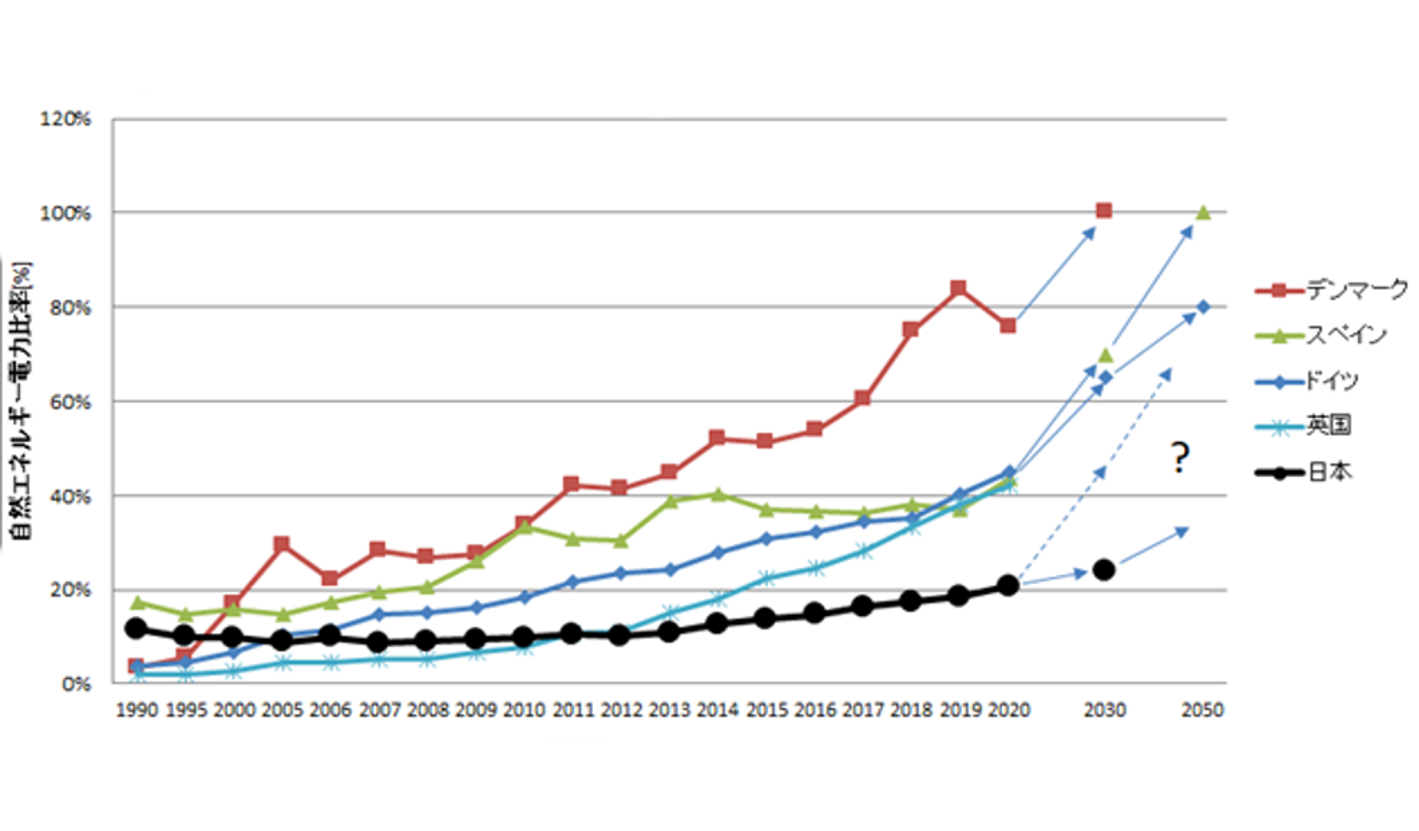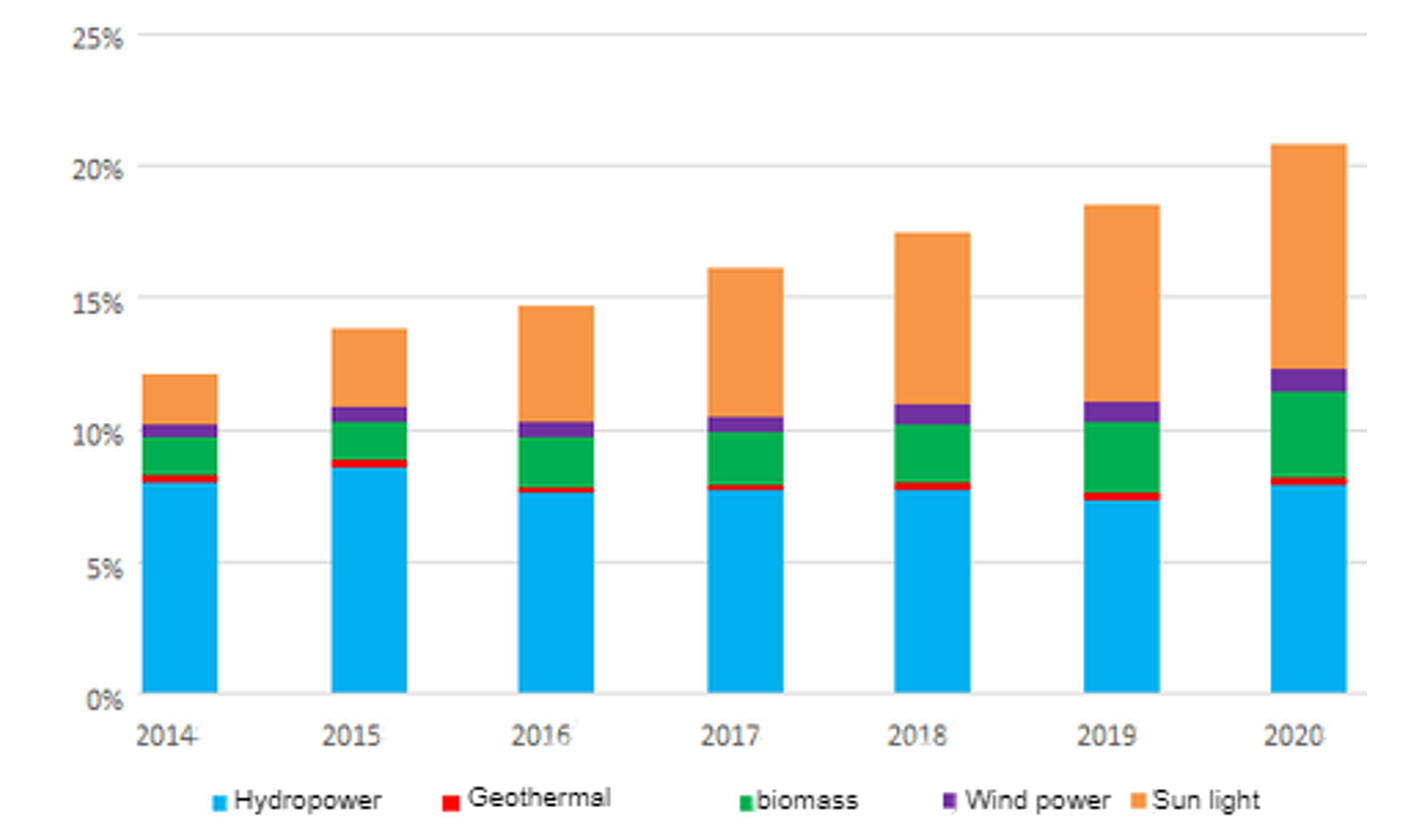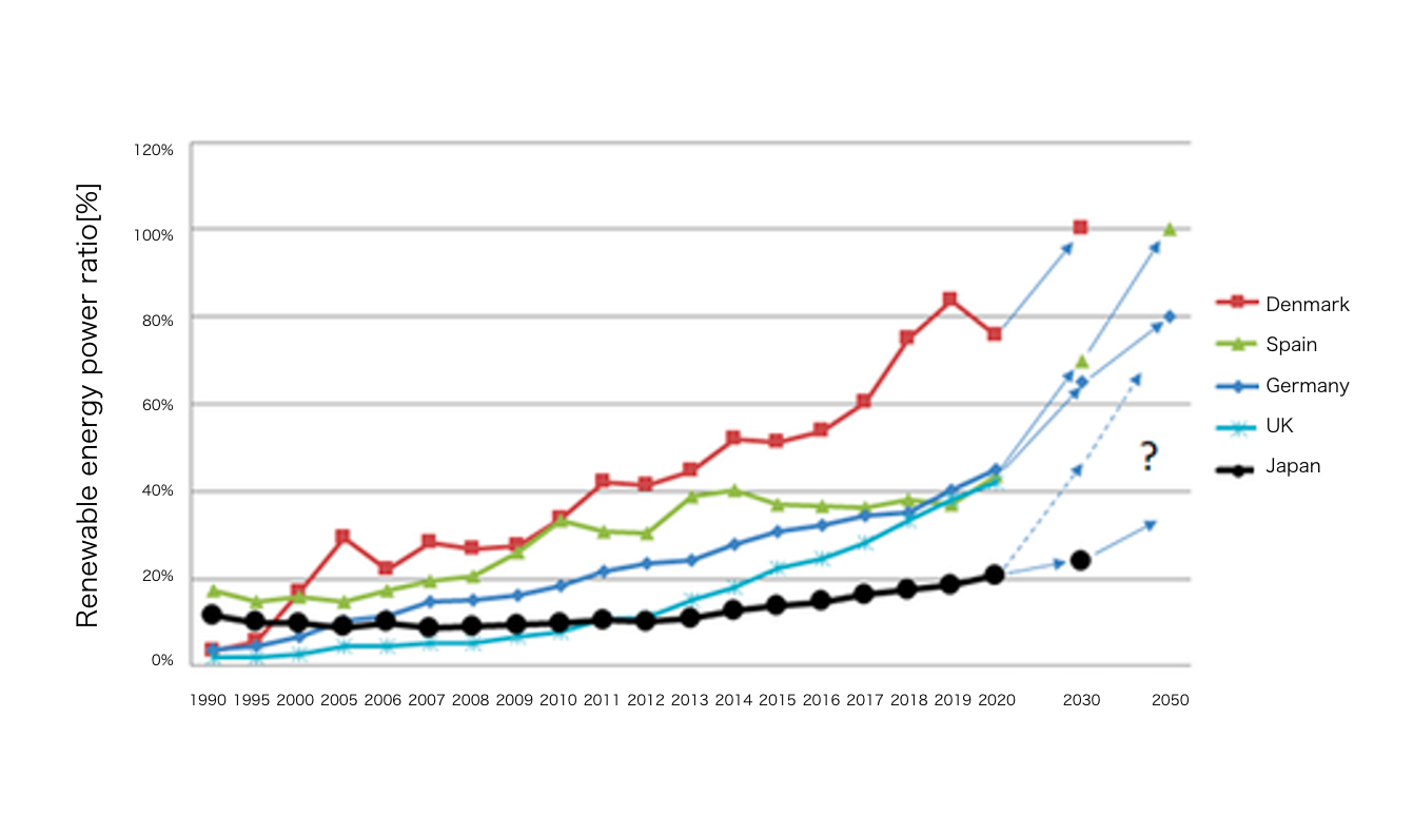 ホーム
ホーム
 エネルギー状況
エネルギー状況 再生可能エネルギー
再生可能エネルギーについて
 エネルギーを考える
エネルギーを考える 節電意識チェック
節電意識チェック まとめ
まとめ Language
Language日本と世界のエネルギー状況
このページでは、日本と海外の発電に用いられている化石燃料や自然エネルギーの割合、その推移について調べました。
また、日本と世界のエネルギー自給率を比べました。
※このページは画像をクリックしていただくと拡大される仕様になっています。
図1:日本全体の電源構成(2020年速報) 出所:電力調査統計などよりISEP作成
環境エネルギー政策研究所(ISEP)のまとめによると、2020年の日本国内の全発電電力量に占める自然ネルギーの割合は、前年の18.5%から20.8%に増加したと推測されます。
しかしながら、化石燃料による火力発電の発電量割合は前年から横ばいで74.9%と依然と高いレベルにあります。
原子力発電は2014年にゼロになってから、2015年以降、毎年発電電力量が増加し2019年には6.5%になりましたが、2020年には4.3%に減っています。
図2:日本の全発電電力量に占める自然エネルギーの割合の推移 (出所:電力調査統計などよりISEP作成)
2014年には12%だった自然エネルギーの割合が、毎年1ポイント程度ずつ増加し、2020年には20%以上に達しました。
欧州各国および中国・日本の発電電力量に占める自然エネルギー等の割合の比較(2020年)出所:Agora Energiewende, China Energy Potal, 電力調査統計などのデータよりISEP作成
左図は主要な欧州各国の自然エネルギーによる2020年の年間発電電力量の割合の内訳となります。
自然エネルギーの割合はオーストリアでは80%近く、デンマークでは76%、スウェーデンでは68%、ポルトガルでは58%に達し、イタリア、ドイツ、イギリス、スペインにおいて自然ネネルギーの割合は40%以上に達しています。
原発の比率が70%近くに達するフランスでは、自然エネルギーの割合は20%程度にとどまっています。
欧州各国および日本の自然エネルギー電力の導入実績・目標(出所:EU統計局、Agora EnergiewendeデータなどからISEP作成)
1990年代から2020年までの欧州各国と日本の年間発電電力量に占める自然エネルギーの割合の推移を比べると、欧州各国では2020年に向けて1990年代から着実に自然エネルギーの割合を増やしてきたことがわかります。
例えばデンマークでは、2000年の時点ですでに17%でしたが、2010年の時点で30%を超え、2020年には75%に達しており、2030年までには100%を超えることを目指しています(図右)。
ドイツは2000年には7%程度でしたが、その後、2010年には20%近くにまで増加し、2020年には45%に達し、2030年には65%以上、2050年には80%以上を目指しています。
ここまでの感想・コメント
日本ではまだ7割以上のエネルギーを化石燃料に頼っていることがわかりました。
原子力発電は日本全国に原発を建て、お金をかけている割に、現状我々のエネルギーを作っている割合としてはとても少ないのだと知りました。
自然エネルギーの割合が原発の5倍もあることは意外でした。
一方で、欧州各国と比べると、日本の自然エネルギーの割合はまだまだ低いことがわかりました。
デンマークが電力の半分を風力でまかなっていることに驚き、調べたところ、洋上に風力発電機をたくさん建てている写真が多く見受けられました。
海洋汚染などの影響はどの程度あるのかなど、デンマークの今後の動きにも注目していきたいと思います。
世界と日本のエネルギー自給率
資源エネルギー庁の調べによると、2018年の日本の自給率は11.8%です。
10年ほど前の2010年には自給率が20.3%あったのですが、さまざまな要因が重なり、現在の水準となっています。
自給率が低い大きな原因として、国内にエネルギー資源がとぼしいことがあげられます。
石油・石炭・液化天然ガス(LNG)などの化石燃料は、海外からの輸入に大きく依存しています。
さらに、2011年の東日本大震災の影響で国内の原子力発電所が停止し、化石燃料への依存は高まっています。
日本は原油輸入の約92%を中東に依存しておりますが、中東は政情がとても不安定な地域です。
2019年6月には原油等の重要な輸送路であるホルムズ海峡近くのオマーン湾で、日本関係船舶などが攻撃を受けるという事件も発生しています。
もしホルムズ海峡の航行が難しくなると、世界のエネルギー価格が高騰するであろうといわれています。
こうした事態に備え、日本では約200日分の石油の備蓄をおこなっています。
感想・コメント
日本のエネルギーの自給率の低さに驚きました。
最近、ガソリンが高くなり、以前よりも車での送り迎えが減っているのは気づいていましたが、私たちの生活に直結するエネルギーのほとんどを輸入に頼っているという事実に、少し怖くなりました。
エネルギー自給率が700%のノルウェーのことが気になり調べてみました。
ノルウェーでは、1970年代から北海で油田開発を行い、石油やガスが産出されるようになりましたが、自国の電力はほぼ水力発電でまかなわれ、産出された石油・ガスを自国でほとんど使わずに、輸出に回しているとの事実を得ました。
油田を開発しながらも、同時に自然エネルギーの開発を行って来た結果が、日本の自給率との差なのでしょうか。
そこで原発にお金をかけてきた日本との明暗が分かれたように感じます。
まとめ
自分たちのエネルギーは自分たちで賄いたいと、私たちは考えます。
化石燃料に頼らず、自分たちの身の回りでエネルギーを作り出すことはできないでしょうか?
Energy situation in Japan and the world
On this page, we investigated the ratio of fossil fuels and renewable energy used for power
generation in Japan and overseas, and their transition. We also compared the energy
self-sufficiency
rates of Japan and the world.
Click to enlarge the image on this page!!
Figure 1: Power source composition for Japan as a whole (preliminary report for 2020) Source: Created by ISEP based on power survey statistics, etc.
According to the summary of the Institute for Environmental Energy Policy (ISEP), it is estimated that the ratio of natural energy to the total power generation in Japan in 2020 increased from 18.5% in the previous year to 20.8%. However, the ratio of fossil fuel-fired power generation has remained unchanged from the previous year at 74.9%, which is a high level as before. Since the number of nuclear power generation became zero in 2014, the amount of power generated has increased every year since 2015, reaching 6.5% in 2019, but decreasing to 4.3% in 2020.
Figure 2: Changes in the ratio of renewable energy to the total amount of electricity generated in Japan (Source: Created by ISEP based on power survey statistics, etc.)
The ratio of renewable energy, which was 12% in 2014, increased by about 1 point every year and reached more than 20% in 2020.
Comparison of the ratio of renewable energy, etc. to the amount of power generated by European countries and China / Japan (2020) Source: Created by ISEP from data such as Agora Energiewende, China Energy Potal, and electricity survey statistics
Comparing the changes in the ratio of renewable energy to the annual power generation of European countries and Japan from the 1990s to 2020, European countries have steadily increased the ratio of renewable energy from the 1990s toward 2020. I understand. In Denmark, for example, it was already 17% in 2000, but exceeded 30% in 2010, reached 75% in 2020, and aims to exceed 100% by 2030. (Right of the figure). Germany was around 7% in 2000, then increased to nearly 20% in 2010, reached 45% in 2020, more than 65% in 2030, and 80% in 2050. We are aiming for the above.
Impressions and comments so far
It turns out that more than 70% of Japan's energy still depends on fossil fuels. I learned that nuclear power is a very small percentage of our energy at present, even though we are spending money on building nuclear power plants all over the country. It was surprising that the ratio of renewable energy is five times that of nuclear power plants. On the other hand, it was found that the proportion of renewable energy in Japan is still low compared to European countries. When Denmark found it amazing that half of its electricity was supplied by wind power, many photos of many wind power generators being built offshore were searched. I would like to pay attention to the future movement of Denmark, such as the extent of the impact of marine pollution.
Impressions / comments
It turns out that more than 70% of Japan's energy still depends on fossil fuels. I learned that nuclear power is a very small percentage of our energy at present, even though we are spending money on building nuclear power plants all over the country. It was surprising that the ratio of renewable energy is five times that of nuclear power plants. On the other hand, it was found that the proportion of renewable energy in Japan is still low compared to European countries. When Denmark found it amazing that half of its electricity was supplied by wind power, many photos of many wind power generators being built offshore were searched. I would like to pay attention to the future movement of Denmark, such as the extent of the impact of marine pollution.
World and Japan energy self-sufficiency rate
According to a survey by the Agency for Natural Resources and Energy, Japan's self-sufficiency rate in 2018 was 11.8%. About 10 years ago, in 2010, the self-sufficiency rate was 20.3%, but due to various factors, it is at the current level. The major reason for the low self-sufficiency rate is the lack of energy resources in Japan. Fossil fuels such as petroleum, coal and liquefied natural gas (LNG) are heavily dependent on imports from abroad. Furthermore, due to the effects of the 2011 Great East Japan Earthquake, domestic nuclear power plants have been shut down, and dependence on fossil fuels is increasing. Japan depends on the Middle East for about 92% of its crude oil imports, and the Middle East is a region of very unstable political situation. In June 2019, there was an incident in which Japanese vessels were attacked in the Gulf of Oman near the Strait of Hormuz, which is an important transportation route for crude oil. It is said that if the Strait of Hormuz becomes difficult to navigate, global energy prices may rise. In preparation for such a situation, Japan is stockpiling oil for about 200 days.
Impressions / comments
I was surprised at the low energy self-sufficiency rate in Japan. I've noticed that gasoline is getting higher these days and less car pick-ups than before, but I'm a little scared to rely on imports for most of the energy that is directly linked to our lives. I was curious about Norway, which has a self-sufficiency rate of 700%, so I looked it up. In Norway, oil and gas have been produced in the North Sea since the 1970s, but the electricity produced in the country is mostly hydroelectric, and the produced oil and gas are hardly used in the country and exported. It is said that it is being turned to. Is the result of developing oil fields and at the same time developing renewable energy the difference from Japan's self-sufficiency rate? I feel that the light and darkness of Japan, which has spent money on nuclear power plants, has been divided.
summary
We want to cover our energy by ourselves. Can we make energy around ourselves without relying on fossil fuels?









